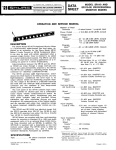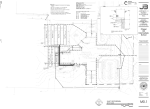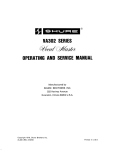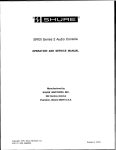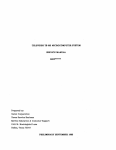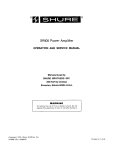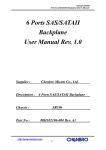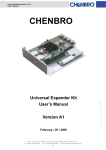Download Shure SR10 Service manual
Transcript
2 2 2 HARTREY AVE.. EVANSTON, IL. 6 0 2 0 4 u.S.A. AREA CODE 3 1 2 / 8 6 6 - 2 2 0 0 TWX: 9 1 0 - 2 3 1 - 0 0 4 8 . CABLE: SHUREMICRO TELEX 72-4381 1 SHEET DATA MODEL SR106 AND SR106-2E ELECTRONIC CROSSOVERS OPERATION AND SERVICE MANUAL Voltage Gain ..............0 2 1 dB (low or high frequency output) with 47-kilohm output termination - 1.5 1 dB with 600-ohm output termination + The Shure Model SR106 Electronic Crossover is a selectable-frequency dividing network, designed for use with two- or three-way speaker systems such as the Shure SR108 Extended Range Speaker System in high-quality sound systems. It utilizes the principle of biamplification to separate an audio console or mixer-preamplifier output into two frequency bands for distribution to separate power amplifiers. In this manner, the advantages of low distortion, increased highfrequency power, wide dynamic range, and maximum efficiency are obtained. DESCRIPTION The SR106 provides crossover frequencies of 500 Hz, 800 Hz and 2600 Hz. It can be used to provide two output frequency bands or, in conjunction with a second SR106, to provide three output frequency bands, with each output routed to a separate power amplifier (triamplification). The SR106 contains both professional three-pin and phone jack input and output connectors, and can be operated in line level balanced and unbalanced systems. The SR106 is designed for maximum simplicity of operation and maintenance. A frequency-selector switch and a power on-off switch are the only controls. Silicon transistors and other solid-state devices are used throughout. All components are of the highest quality and are operated well within their respective ratings to assure maximum reliability under normal use conditions. The SR106 and SR106-2E are identical except that the SR106 operates from 108-132 Vac, and the SR106-2E operates from either 105-125 or 210-250 Vac (switch-selectable). All SR106 Series units are supplied with four rackmounting screws for mounting in 483 mm (standard 19 in.) audio equipment racks or in optional Shure A30A or A105A Carrying Cases. In addition, the SR106 is supplied with a protective power switch cover and the SR106-2E is supplied with an ac line cord (without power plug). The SR106 (only) is listed by Underwriters' Laboratories, Inc., and is listed by Canadian Standards Association as certified. Input Sensitivity ........1-volt input produces I-volt output (unity gain) with 47-kilohm output termination I-volt input produces 0.84-volt output with 600-ohm output termination Frequency Response ................ Electrical sum of outputs (phase reversed): flat t 2 dB, 20-20,000 HZ High-frequency output: 12 dB/ octave rolloff below crossover Low-frequency output: 6 dB/ octave rolloff above crossover (see Figure E) Phase ........................ ..Input and low frequency output connectors in phase, high frequency output reversed phase lnput Common Mode Rejection ......92 dB minimum at 100 Hz Input Impedance ........47 kilohms Total Harmonic Distortion ................1% max. (I-volt input; low frequency: 20-2,600 Hz; high frequency: 500-20,000 Hz) Hum and Noise .......... - 96 dBV max. low or high frequency output (through 20,000 Hz noise-bandwidth filter with 20 Hz lower cut-off; 600-ohm source, 47-kilohm output terminations) Noise ..........................- 98 dBV max. low or high frequency output (through 20,000 Hz noise-bandwidth filter with 300 Hz lower cut-off; 600-ohm source, 47-kilohm output terminations) Clipping Level ............ + 18 dBm (6.2V) min. input from 30-20,000 Hz with 600-ohm or greater output loads. SPECIFICATIONS Recommended Output Load Impedance ....600 ohms minimum (115 ohms actual output impedance) Type ............................ All silicon transistor electronic crossover network Crossover Frequency .............. 500 Hz, 800 Hz or 2600 Hz (selectable) Power Supply ............SR106: 120 volts t l o % , 50/60 Hz ac only. SR106-2E: 105-125 or 210-250 volts, 50/60 Hz ac only. Power consumption: 3 watts maximum. Copyright 1979, Shure Brothers 27A1145 (SF) Inc. Printed in U.5.A I FIGURE A. SR106 FRONT PANEL Temperature Range: Operating ................ - 7" to 57°C (20" to 135°F) Storage .............._ - 29" to 71 "C (-20" to 160°F) 8. Dimensions ................ 44.5 mm height x 483 mm width x 216 mm depth (1% in. x 19 in. x 8% in.) 9. Weight ........................ 3 kg (6 Ib, 8.8 oz) Finish .......................... Matte black Installation .................. Equipped for standard 483 mm (19 in.) audio rack mounting; may be operated in optional A30A or A105A Carrying Case (with other equipment) 10. Certifications 12. .............. ~ i s t e dby Underwriters' Laboratories, Inc.; listed by Canadian Standards Association as certified (SR106 only) 11. or 2600 Hz for separation of high- and lowfrequency signals to power amplifiers. LlNE LEVEL INPUT 3-Pin Female ConnectorProvides balanced bridging, high-impedance input connection from audio console or mixerpreamplifier. May be unbalanced externally. LlNE LEVEL INPUT Phone Jack-Provides balanced or unbalanced bridging, high-impedance input connection from audio console or mixerpreamplifier. Ac Grounded Line Cord-Connects unit to ac power source (SR106 only). AC (MAINS) POWER 3-Pin Connector-Connects unit to ac (mains) power source via supplied line cord (SR106-2E only). VOLTAGE SELECTOR Slide Switch-Selects 115V or 220V input power (SR106-2E only). General Operating Instructions OPERATING INSTRUCTIONS WARNING Functional Description (Refer to Figures A and B) 1. Power-On Indicator Lamp-Indicates ac power is being applied to unit. 2. POWER ON-OFF Switch-Controls ac power to unit. 3. LlNE LEVEL OUTPUTS/LOW FREQUENCY 3Pin Male Connector-Provides low-frequency balanced output connection to power amplifier. May be unbalanced externally. 4. LlNE LEVEL OUTPUTS/LOW FREQUENCY Phone Jack-Provides low-frequency balanced or unbalanced output connection to power amplifier. 5. LlNE LEVEL OUTPUTS/HIGH FREQUENCY Phone Jack-Provides high-frequency balanced or unbalanced output connection to power amplifier. 6. LlNE LEVEL OUTPUTS/HIGH FREQUENCY 3Pin Male Connector-Provides high-frequency balanced output connection to power amplifier. May be unbalanced externally. 7. CROSSOVER FREQUENCY Slide SwitchSelects crossover frequency of 500 Hz, 800 Hz MTIM II 1. Using hardware provided, install SR106 securely in 483 mm (standard 19 in.) rack or optional A30A or A105A Carrying Case prior to making electrical connections. 2. Connect SR106 LlNE LEVEL OUTPUT/LOW FREQUENCY 3-pin connector or phone jack (3, 4) to (low frequency) power amplifier line level input. 3. Connect SR106 LlNE LEVEL OUTPUT/HIGH FREQUENCY &pin connector or phone jack (5, 6) to second (high frequency) power amplifier line level input. 4. Connect audio console or mixer-preamplifier line level output to SR106 LlNE LEVEL INPUT &pin connector or phone jack (8, 9). 5. Make sure speaker systems are properly connected to power amplifiers and are adjusted for biamplified operation. t if(TOR rr To reduce the risk of fire or electric shock, do not expose this appliance to rain or extreme moisture. rolula 3 whr SR106-2E ONLY \12 10 3 FIGURE B. SR106 REAR PANEL 7 8 9 6. Move CROSSOVER FREQUENCY Switch (7) to select proper crossover frequency (see Speaker Operating Instructions). 7. (SR106-2E only) Move VOLTAGE SELECTOR Switch (12) to 115V or 220V position as desired. 8. Connect ac line cord to grounded 108- to 132volt (SR106), or 105-125V or 210-250V (SR1062E), 50/60 Hz ac source. 9. Turn on front-panel POWER ON-OFF Switch (2). Red indicator lamp (1) will go on, indicating power application. The SR106 is now operating. 1@. Adjust audio console or mixer-preamplifier and power amplifier controls for desired operating levels. Mounting and Ventilation The SR106 Electronic Crossover is designed for rack-mounting in a 483 mm (standard 19 in.) audio equipment cabinet rack and is supplied with the necessary mounting hardware (see Figure C). If possible, the SR106 should be rack-mounted below its associated power amplifiers. The SR106 may also be operated while mounted in a Shure A30A or A105A Carrying Case. The A30A has a panel height capacity of 88.9 mm (3Y2 in.), providing space for two SRlOG's, or one SR106 and one other unit of 44.5 mm (1% in.) height. The A105A has a panel height of 178 mm (7 in.), providing space for up to four SRlO6's, or one SR106 and other equipment totaling 133.4 mm (5Y4 in.) in height. No special precautions are required for ventilation. The SR106 may be operated over a temperature range of - 7" to 57°C (20" to 135°F) in continuous duty without derating. 483 mm (19 1N! -44 'NOT 4 mrn(1-3/4 IN, lNCLUDlN6 CABLE/CONNECTOR CLEARANCE DEPTH FIGURE C. OVERALL DIMENSIONS Power Supply The SR106 is furnished with a three-conductor power cable and three-prong grounded plug (10). Connect LlNE LEVEL INPUT the SR106 to an outlet which supplies 108 to 132 volts ac, 50/60 Hz power. Maximum power consumption at 120 volts under normal operating conditions is 3 watts (0.025 amperes at 120 volts). If extension cords are required, a high-quality, 18-gauge or larger cord should be used. The SR106-2E is furnished with a three-conductor line cord without a power plug. Obtain a suitable 3-pin male power plug and attach it to the line cord. The plug should be installed by qualified service personnel. (Brown lead goes to "hot" or "live" terminal, blue lead to neutral terminal, and greenfyellow lead to ground or earth terminal.) Select proper operating voltage (115V for 105-125V supply or 220V for 210-250V supply) using the VOLTAGE SELECTOR Switch (12). A POWER ON-OFF toggle switch on the front panel (2) controls the application of ac power to the SR106, and a red indicator lamp (1) indicates the power-on condition. The tamper-proof cover supplied (SR106 only) may be used to eliminate accidental movement of this switch. Functional Circuit Description The inputs of the SR106 Electronic Crossover consist of one phone jack (9) and one three-pin female audio connector (8) (see Figure D). The phone jack is a three-circuit (stereo) type and is wired in parallel with the three-pin connector to provide a balanced input with either connector. The input signal then passes through a 6 dB stepdown input isolation transformer to a unity-gain buffer amplifier. The next stage is a 12 dB/octave high-pass filter with an operating frequency of 500 Hz, 800 Hz or 2600 Hz. All frequencies above the selectable operating frequency are routed to a unity-gain filter amplifier stage. One output of this stage goes to a 6 dB gain, 600-ohm line driver, which drives the high-frequency output transformer to + I 8 dBm. The other output goes to a differential amplifier/line driver stage, which also receives an input from the first buffer amplifier stage. The differential amplifier/line driver stage thus derives the low-pass signal by responding to the difference between the buffer amplifier signal (all-pass) and the filter circuit signal (high-pass). The difference signal ampli.tude rolls off at 6 dB/octave. The difference signal is amplified and drives the low-frequency output transformer. The resulting frequency response curves are shown in Figure E. Adding the two outputs out-of-phase provides a flat output response from 20 to 20,000 Hz. High- and low-frequency outputs appear on both phone jacks and three-pin, professional, male audio connectors. HIGH-PASS FILTER -------- --- - - -- - -1 HIGH FREQUENCY LEVEL OUTPUTS LINE LOW FREQUENCY LlNE LEVEL OUTPUTS FIGURE D. BLOCK DIAGRAM Input and Output Connections Two LlNE LEVEL INPUT Connectors are located on the rear panel of the SR106. A professional, three-pin female audio connector (8) provides a balanced connection from the audio console or mixer-preamplifier. A standard 1/4 in. three-circuit (stereo) phone jack (9) provides either a balanced or unbalanced input connection. The SR106 is a unity gain device, that is, a 1-volt input signal provides a 1-volt output signal. The SR106 may be driven by virtually any mixer, audio console or mixer-preamplifier. When connecting the source output to the SR106, follow the instructions supplied with the source equipment with regard to connectors and cabling. Note that if a two-circuit phone plug is used, the SR106 input will automatically become unbalanced. HlGH FREQUENCY and LOW FREQUENCY LlNE LEVEL OUTPUT connectors consist of both professional, three-pin, male audio connectors (3, 6) for balanced connection to power amplifiers, and standard 1/4 in. three-circuit (stereo) phone jacks (4, 5) provide balanced or unbalanced connections. + 10 m P 0 w 0 B -10 W W :- 2 0 w -30 20 50 100 200 400 600 FREQUENCY 1K 2K 4K IOK 6K 2OK (HZ ) CROSSOVER FREQUENCY: 2600 Hz Biamplification The principle of biamplification is to separate the high- and low-frequency signal components ahead of the power amplifier, and to use separate power amplifiers for each section of a two-way speaker system (see Figure F). Proper matching of amplifiers and speakers, increased system power, and reduced distortion may be realized. With biamplification it is possible to power-match each speaker system section to a power amplifier for maximum efficiency, whereas if a single equivalent high-power amplifier were used it would exceed the speaker system power rating. The improved system performance using separate power amplifiers for each speaker section may be that of a single high-power amplifier whose rating is up to twice the sum of the individual power amplifiers. In addition, the power amplifier overload caused by high-level, low-frequency signals severely degrades high-frequency signals in a single-amplifier system. This overload, a form of intermodulation distortion, is eliminated by the use of separate power amplifiers. Biamplification also eliminates low-frequency distortion produced by saturation of iron cores used in some passive speaker crossover networks. CROSSOVER FREQUENCY: 800 Hz +I0 m a 0 I 0 -10 Y ", 5 -20 W -30 20 50 100 200 400 600 1K 2K 4K 6K IOK 20K CROSSOVER FREQUENCY: 500 Hz FIGURE E. FREQUENCY RESPONSE TWO-WAY SPEAKER SYSTEM r------POWER AMPLIFIER HIGH H AUDIO CONSOLE OR MIXER-PREAMP OR MIXER i I I - HIGH-FREQUENCY SPEAKERS 1 I I I SR106 ELECTRONIC CROSSOVER LOW - POWER AMPLIFIER FIGURE F. BlAMPLlFlED OPERATION II I I LOW-FREQUENCY SPEAKERS I I I The outputs of the power amplifiers in a biamplification system may be connected to any high-power, two-way speaker system with separate driver connections such as the Shure SR108. The only important restriction placed on speaker systems is that the crossover frequency of the speaker system must match the crossover frequency selected on the back of the SR106. Damage to the high-frequency drivers may result if the crossover frequency of the SR106 is set below that recommended for the speaker system. For three-way speaker systems, a second SR106 may be used to split the high-frequency output of the first SR106 into mid-range and high-frequency outputs. The two SRlO6's thus separate the line level signal into three components for routing to three power amplifiers and into the three-way speaker system (see Figure G). This is called triamplification, and may be used with any three-way speaker system with crossover frequencies matching those of the SR106. NOTE: Certain three-way speaker systems are designed for biamplified operation only, and use their internal crossover networks to separate the mid- and high-frequency signals. When using a speaker system of this type, follow the instructions under Biamplification and the speaker system manufacturer's instructions. Crossover Frequencies The three crossover frequencies available (500, 800 and 2600 Hz) on the SR106 rear-panel selector switch (7) are designed for use with the Shure SR108 Extended Range Speaker System (2600 Hz) and other popular speaker systems. In connecting the SR106, it is imperative that the crossover frequency of the speaker system be known and the SR106 CROSSOVER FREQUENCY Switch be set before operating the system. CAUTION High-frequency drivers may be damaged or destroyed if the electronic crossover is not set to match the speaker system crossover frequency. Phasing The SR106 high- and low-frequency output signals are intentionally wired out of phase (opposite polarity). The low-frequency output is in phase with the input, and the phase of the high-frequency output is reversed. This phase relationship is consistent with the requirements of the passive 12 dB/octave crossover networks used in most popular speaker systems. The Shure SR108 Extended Range Speaker System is internally wired out of phase and provides the correct acoustic output when operated in the biamplification mode. Proper wiring is necessary to maintain the correct phase relationship of the high- and low-frequency speakers in the crossover region. Failure to maintain proper phasing may cause incorrect overall response characteristics in the critical mid-range frequencies. The speaker system instruction manual should be consulted for information on proper phasing when connecting the speakers to the power amplifiers. The following considerations should be given to phasing: When using the SR106 and identical power amplifiers (Shure SR105 or equivalent) to power a Shure Model SR108 Speaker System, the phasing is correct. Different speaker systems or dissimilar highand low-frequency power amplifiers may be used as long as all low-frequency sections are in phase with one another and all high-frequency sections are in phase with one another, as well as maintaining proper high- to low-frequency phasing. To check for a possible out-of-phase condition in a single speaker system (high- to low-frequency phasing), the following listening test should be performed. Connect the SR106, program input equipment, and power amplifiers to a single speaker system. Feed the system with program material (vocal or instrumental) and adjust for a moderate level. Listen carefully to the speaker system output and reverse the phase of either the high- or low-frequency section of the speaker system while listening to the same program material. Choose the connection that produces the most uniform sound quality. If a crossover frequency other than the three provided (500, 800, and 2600 Hz) is desired a qualified service technician can change the crossover frequency to a new desired frequency. Refer to the section on Alternate Crossover Frequencies. CAUTION Do not interchange high- and low-frequency speaker cables. Damage to high-frequency drivers from high level, low-frequency signals may result. SPEAKER SYSTEM - H AUDIO CONSOLE OR MIXER-PREAMPOR MIXER - SR106 CROSSOVER ( 5 0 0 HZ) E SRlO6 ELECTRONIC CROSSOVER ( 2 6 0 0 HZ) - - HIGH MID (LOW) - LOW POWER AMPLIFIER POWER AMPLIFIER POWER AMPLIFIER r------- I I I I I I I I I I , HIGH-FREQUENCY SPEAKERS MID-FREQUENCY SPEAKERS 7 I I I I I I I LOW-FREQUENCY SPEAKERS I I I L-------J FIGURE G. TRlAMPLIFIED OPERATION The second test should be made feeding two speaker systems at a time with the same vocal or instrumental program material or noise (pink or white). Connect the SR106, power amplifiers, speaker systems, and program input equipment. Turn on the sound system and adjust for a moderate level. Disconnect the high-frequency driver input cables. Stand approximately mid-way between the two speaker systems and listen to the program material while reversing the "hot" and common leads to one of the low-frequency speaker sections. (This may be accomplished by wire-reversing or by a simple crosswired, double-pole, double-throw switch.) Use the connection that gives a localized sound, centered between the speaker systems; this is the correct phase connection. A diffuse, directionless sound indicates improper phasing. Reconnect the high-frequency speaker sections and disconnect the low-frequency sections. Perform the same test as above. Correct phasing will provide a localized sound, centered between the speaker system; incorrect phasing is indicated by the sound appearing to come predominantly from one speaker system, and to shift from one speaker system to another as the listener moves around the audience area. If it becomes necessary to invert the phase of the SR106 output signal without changing any wiring, a Shure A15PR Phase Reverser may be inserted in the LINE LEVEL OUTPUTS/HIGH FREQUENCY or /LOW FREQUENCY three-pin connector (6, 3) of the SR106. Shelving In normal operation the flat portions of the passbands of the SR106 high- and low-frequency outputs are at equal levels (see Figure E). However, because of the wide variance in acoustically "live" and "dead" rooms, it is often necessary to "shelve," or adjust, relative to one another, the high- and low-frequency signals in order to compensate for room reflection or absorption. This is done by decreasing the volume or output level setting on the desired power amplifier (high- or low-frequency) to some arbitrary position below that of the other power amplifier, and performing a listening test to establish that the desired compensation has been achieved. The effects of shelving the high- and low-frequency outputs are shown in Figures H and J, respectively. + 10 - m W p 0 W W z -I0 2 0 50 100 200 400 600 IK 2K 4K 6K IOK 2OK FREWNCY (HZ) FIGURE J. TYPICAL SHELVING EFFECT: LOW TO HlGH FREQUENCY SPECIAL OPERATING INSTRUCTIONS The following information is supplied to enable the user to utilize the SR106 Electronic Crossover in special or custom installations. WARNING Voltages in this equipment are hazardous to life. Make all circuit changes described in this section with ac power disconnected. Circuit changes should be referred to qualified service personnel. Alternate Crossover Frequencies The crossover frequency is determined by a single two-pole, 12 dB/octave, high-pass, active filter. Transsistors Q3 and Q4 and associated circuitry, including capacitors C4 to C13, comprise this filter. In the 2600 HZ position of switch S1 capacitors C4 and C13 determine the crossover frequency. In the 800 and 500 HZ switch positions capacitors C5 to C12 are selectively added in parallel to produce a lower crossover frequency. Should a different crossover frequency than those provided be desired for use with a special custom speaker system, capacitors C4 and C13 may be replaced. The two capacitors have the same value; to determine the new value capacitor required in microfarads, divide 7.02 by the desired crossover frequency. Example: +I0 If the new crossover frequency is to be 1500 Hz, m 0 + U. g Use 5% tolerance, 50-volt or greater capacitors. Stable film-type capacitors, matched within 10% or better, are recommended. 0 W Y L? z W - 10 20 50 100 200 400 600 FREWENCY IK 2K 4K [HZ) FIGURE H. TYPICAL SHELVING EFFECT: HlGH TO LOW FREQUENCY 6K IOK ZOK The new crossover frequency is 1500 Hz with the switch in the 2600 HZ switch position. Note that the crossover frequencies corresponding to the 500 HZ and 800 HZ switch positions are also different due to the change in capacitors C4 and C13. Be sure to note the new crossover frequency on the switch position to avoid damage due to accidental connection to another speaker system. Adding Level Controls If the power amplifiers in use do not have volume controls, or if volume controls are desired at the SR106 location, external controls may be added to the SR106 outputs. Obtain two 1,000-ohm linear taper potentiometers (Allen-Bradley Type J or equivalent) and mount them in a 44.5 mm (1% in.) rack panel. Wire the potentiometers to the SR106 output as shown in Figure K. WARNING Voltages in this equipment are hazardous to life. Refer servicing to qualified service personnel. Replacement Parts Parts that are readily available through local electronic parts distributors are not shown on the accompanying Parts List. Their values are shown on the Circuit Diagram (Figure P). Commercial parts not readily available and unique parts are shown on the Parts List and may be ordered directly from the factory. For shelving adjustments, set the controls to maximum volume position (full clockwise) and reduce one control for the desired effect. FROM SR106 OUTPUT TO POWER AMPLIFIER INPUT T - ONE-HALF The commercial alternates shown on the Parts List are not necessarily equivalents, but are electrically and mechanically similar, and may be used in the event that direct factory replacements are not immediately available. To maintain the highest possible performance and reliability, Shure factory replacement parts should be used. When ordering replacement parts, specify the Shure Replacement Kit Number, description, product model number and serial number. OF CIRCUIT SHOWN FIGURE K. LEVEL CONTROL WIRING Telephone Line Surge Protection When using the SR106 to feed a telephone line subject to lightning-induced voltage surges, the following part (commercially available) can be installed across the LINE LEVEL OUTPUTSIHIGH FREQUENCY and /LOW FREQUENCY three-pin jacks (6, 3) or phone jacks (5, 4) to provide additional protection for output circuit components: Thyrector, General Electric Co., Part number 6RS20SPl B1. Cover Removal To service components inside the chassis, the protective top cover must be removed. This is done by removing 10 screws from the top surface and lifting the cover off. Printed Circuit Board Removal The SR106 chassis contains a printed circuit board assembly. The foil side of the board may be made accessible for servicing, without disconnecting any leads, by removing the four Phillips head screws securing the board. The board may be completely removed as follows (see Figure L). Remove all 14 interconnecting leads from the push-on board terminals, noting connections as listed in the table below. SERVICE INSTRUCTIONS Service (See Guarantee) The SR106 Electronic Crossover uses components of the highest quality, operating well within their respective ratings to assure long life. T2 AI CII T3 CIO T4 TI D2 C6 J5 J6 C5 RI J3 SI FIGURE L. SR106 TOP VIEW, COVER REMOVED CI C2 CAUTION Similar wire colors are used in different circuits; make sure proper re-connections can be made. Take care not to bend or break the push-on terminals. CIRCUIT BOARD WIRE COLORS Letter Wire Color Letter Wire Color To check transistors, the ohmmeter should be set to the 100- or 1,000-ohm scale. Transistors and diodes must be removed from the circuit before testing. If all conditions in the following table are met, the transistor may be considered free of any major defect; if any of the following conditions are not met, the transistor should be replaced. See Notes to Circuit Diagram (Figure N) for transistor lead codes. Ohmmeter Connections Ohmmeter Reading A Red H Red "Plus" Lead "Minus" Lead NPN Transistor PNP Transistor B Black J Red Collector Emitter High High C Purple K Blue Emitter Collector High High D Yellow/Purple L Red Collector Base High Low E Yellow/Black M Blue Emitter Base F Yellow/Red N Black Base Collector Low G Black P White Base Emitter Low NOTE: Production variations may result in wire colors differing from those in the table. Remove the four Phillips head screws from the board and remove the board from the chassis. Replace cover after servicing board. Transistor and Diode Removal All transistors and diodes used in the SR106 are mechanically supported by their leads. When replacing these devices, proper lead configurations must be followed. Minimum soldering heat (preferably with a low-wattage soldering iron) should be used to avoid damage to the device. Transistor lead codes are included in the Notes to Circuit Diagram (Figure N). Transistor and Diode Checking Defective transistors and diodes may be located by use of a standard ohmmeter such as a Simpson 260. Polarity of the ohmmeter must be verified before these checks are made. With a known diode orientation, measure the diode resistance in the forward and reverse directions. The lowest meter reading will establish the probe at the cathode end (schematic symbol arrow points to cathode) as the "minus" probe while the other probe will be "plus." Some ohmmeters are not polarized in this manner with relation to "volts plus probe" and "volts minus probe." With the ohmmeter "plus" probe on the anode end of a diode, and the "minus" probe on the cathode end, the ohmmeter should read approximately 2000 ohms or less. With the meter probes reversed, a reading of about 10,000 ohms or more should be obtained. If either of these conditions is not met, the diode should be replaced. Low High *Not a significant measurement. Replacement Parts List The commercial alternates shown in the following parts list are not necessarily equivalent parts, but are electrically and mechanically similar, and may be used if direct factory replacements are not immediately available. To maintain highest possible performance and reliability, Shure Factory Replacement Parts should be used. Service Illustrations The pages that follow contain a Parts Location Drawing for the printed circuit board (Figure M) and an overall Circuit Diagram (Figure P). Foil circuit paths are shown as shaded areas in Figure M. The Circuit Diagram shows all printed circuit board and chassismounted parts. GUARANTEE This Shure product is guaranteed in normal use to be free from electrical and mechanical defects for a period of one year from date of purchase. Please retain proof of purchase date. This guarantee includes all parts and labor. This guarantee is in lieu of any and all other guarantees or warranties, express or implied, and there shall be no recovery for any consequential or incidental damages. SHIPPING INSTRUCTIONS Carefully repack the unit and return it prepaid to: Shure Brothers Incorporated Attention: Service Department 1501 West Shure Drive Arlington Heights, Illinois 60004 If outside the United States, return the unit to your dealer or Authorized Shure Service Center for repair. The unit will be returned to you prepaid. REPLACEMENT PARTS LIST (See Figures L and P) I Reference Designation I I Replacement Kit Consists Of: Replacement Kit No.* Qty. Part No. Commercial Alternate Description CHASSIS-MOUNTED PARTS AND ASSEMBLIES A1 - 90A2058 Printed Circuit Board Assembly None C10 - - 86L628 Capacitor, Electrolytic, 250 ,F, 40V CDE BR250-50 C11 - - 86B632 Capacitor, Electrolytic, 1000 F , , 40V None 4 86A404 Silicon Rectifier, 100V, - 80A297 Fuse, SLO-BLO, 1/16A, 250V, Pigtail (SR106-2E) Littelfuse 315.062 2 95A482 Connector, Female, 3-Pin Audio, LlNE LEVEL INPUT Switchcraft C3F - 95D446 Connector, Phone Jack, 3-Conductor, Open Circuit, LlNE LEVEL INPUT and LOW and HlGH LEVEL OUTPUT Switchcraft 12B 1 95A198 Connector, Male, 3-Pin Audio, LOW and HlGH LEVEL OUTPUT Switchcraft C3M D l , D2 F1 J1 J2, J4, J6 J3, J5 RKC21 - RKC83 - RK122P Y2 A Motorola 1N4002 J7 - - 95A689 Connector, 3-Pin, AC (MAINS) POWER (SR106-2E) None L1-L4 - - 80A250 Ferrite Bead Ring Stackpole 57-0181; Ferronics 21-0351J MP1 - - 39A418 Nameplate, Front-Panel None 31A1144A Cover, Switch, POWER (SR106) None 1 80A79 Lamp, Indicator Leecraft 36N1311-6 - 55A105 Switch, Slide, 4P3T None S2 - - 55A96 Switch, Toggle, SPST, POWER ON-OFF (SR106) Cutler-Hammer 7501K13 S2 - - 55A117 Switch, Toggle, SPST, POWER ON-OFF (SR106-2E) None S3 - - 55A116 Switch, Slide, DPDT, VOLTAGE SELECTOR (SR106-2E) None T1 - - 90C2150 Transformer and Shield Assembly, Line Level Input None T2, T3 - - 518229 Transformer, Low and High Frequency Line Level Output None T4 - 51A253 Transformer, Power (SR106) None T4 - 51A259 Transformer, Power (SR106-2E) None W1 - - 95A632 Line Cord and 3-Conductor Ac Plug Assembly (SR106) Belden 17408 - 90A1888 Line Cord and 3-Conductor Ac Plug Assembly (SR106-2E) None MP2 PL1 S1 W1 RKC45 *Parts listed as RKC Kits should be ordered by that number. Any orders received for piece parts where RKC Kit number is shown will be shipped in RKC quantities. "Sprague Type 225P has a +lo% tolerance; select to &5% if possible. REPLACEMENT PARTS LIST-Continued Reference Designation Replacement Kit Consists Of: Replacement Kit No.* Part No. Qty. Commercial Alternate Description CIRCUIT BOARD ASSEMBLY (Al) Q2, Q 4 0 6 Q10 Q8, Q12 I - RKC66 1 1 - I 1 1 86~348 86A335 1 1 Capacitor, Electrolytic, 4.7 ,F, 35v Sprague 30D-TE1303; CDE NLW-5-50 Capacitor, Electrolytic, 250 p.F, 40V CDE BR250-50 Capacitor, Film, .0027 ,F, 1OOV & 5% Sprague 225P27291* * Capacitor, Film, .0022 ,F, lOOV t 5% Sprague 225P22291** Capacitor, Film, .0039 ,F, 10OV zk 5% Sprague 225P39291*' Capacitor, Film, .0015 ,F, 100V t 10% Sprague 225P15291 Capacitor, Film, .O1 ,F, lOOV t 5% Sprague 225P10391" " Silicon Rectifier, 50V, YzA Motorola 1N4001 Transistor, Silicon, Low Power, NPN Motorola 2N5210 Transistor, Silicon, Low Power, PNP Motorola or Fairchild 2N5087 Transistor, Silicon, PNP *Parts listed as RKC Kits should be ordered by that number. Any orders received for piece parts where RKC Kit number is shown will be shipped in RKC quantities "Sprague Type 225P has a 210% tolerance; select to 2 5 % if possible. FIGURE M. PRINTED CIRCUIT BOARD PARTS LOCATION NOTES TO CIRCUIT DIAGRAM General Shure part numbers are not shown in the Parts List accompanying the Circuit Diagram (Figure P) if parts are readily available through local electronics parts suppliers. In these instances, the Circuit Diagram shows only the reference designation and value of the standard parts. All capacitor values are shown in microfarads unless otherwise designated. All non-electrolytic capacitors are 100 working volts dc or more unless otherwise specified. The capacitor tolerance is shown for the crossover-frequency-determining capacitors C4 to C13. Electrolytic capacitors are shown in microfarads X volts. All resistor values are shown in ohms (k=1000). Resistors are %-watt 10% tolerance unless otherwise specified. Transistor lead codes are shown in Figure N. Acceptable replacements are shown in the Parts List. The following ground symbols denote: *l Chassis Ground Circuit Ground Printed Circuit Board Ground Troubleshooting A general troubleshooting process is as follows: If the SR106 is completely "dead," check the ac power source and power slipply output (36V at pin H of printed circuit board). If the output is distorted, low or not present, apply an input signal as described under Ac Voltage Measurements below, and determine that the input voltage to the board assembly is correct. If an incorrect ac voltage is found on the board, perform Dc Voltage Measurements as described below to isolate the problem area. AC Voltage Measurements on The numbers within rectangular symbols the Circuit Diagram denote the ac voltage at that point under the following test conditions: 1. Voltage measured with respect to chassis unless otherwise indicated. 0 2. Line voltage: 120V, 50/60 Hz (SR106), or 115V or 220V (SR106-2E). 3. Test signal of l.OV, 200 Hz (low-frequency) or 5 kHz (high-frequency) applied across connector J1 through 600 ohms. 4. Measurements made with ac VTVM of 1 megohm or greater input impedance. 5. Loads across LlNE LEVEL OUTPUTS Connectors J3 and J5: 47 kilohms. 6. Ac voltage measurements may vary t 30% from values shown. DC Voltage Measurements The numbers within elliptical symbols o on the Circuit Diagram denote the dc voltage at that point under the following test conditions: 1. Voltages measured with respect to chassis unless otherwise indicated. 2. Line voltage: 120V, 50/60 Hz (SR106), or 115V or 220V (SR106-2E). 3. No input signal applied. 4. Dc voltage measurements may vary t 20% from values shown. 5. Measurements made with VTVM of 11 megohms or greater input impedance. Resistance Measurements With the ac line cord disconnected from the ac source and the POWER ON-OFF Switch in the OFF position, the following ohmmeter measurements may be made: 1. Transformers may be checked for continuity of each winding. 2. To test transistors and diodes, see Transistor and Diode Checking. .@ E 01 03 05 p9 .@ 1- pK77q .a .Q.a(J.6 E E 07.011 E E E 02,P4 E Q8,012 as, a,o FIGURE N. TRANSISTOR LEAD CODES ARCHITECTS' AND ENGINEERS' SPECIFICATIONS * The Electronic Crossover shall be a rack-mounted 120-volt, 50160 Hz line-operated, all silicon transistor, active crossover network for separating the output signals from an audio console or mixer-preamplifier into high- and low-frequency signals for routing to separate power amplifiers and two-way speaker sys" tems. The Electronic Crossover shall be a unity voltage gain amplifier for either high- or low-frequency output signals, with a flat f 2 dB frequency response over the range of 20 to Hz when the high- Or lowfrequency output signals are added electrically out-ofphase. Input impedance shall be 150 kilohms 2 30%, and recommended output load impedance shall be 600 ohms (termination for 1.5 dB loss) or 47 kilohms (bridging for unity gain). The Electronic Crossover shall evidence no visible clipping at either output from 30 to 20,000 Hz with a 15.8 dBV (6.2V) input level. When terminated with a 600-ohm input resistance and 47-kilohm output loads, both high- and low-frequency output signals shall have a maximum hum and noise level of -96 dBV through a 20,000 Hz noise-bandwidth 207000 * All spec~ftcat~ons apply to SR106-2E except operattng voltage 1 2 5 ~or 210-250~. IS 105- filter with a 20 Hz lower cut-off, and a maximum noise level of -98 dBV through a 20,000 Hz noise-bandwidth filter with a 300 Hz lower cut-off. The Electronic Crossover shall have a POWER ONOFF Switch and a three-position CROSSOVER FREQUENCY Switch to select crossover frequencies of 500, 800 or 2600 Hz. The Electronic Crossover shall be enclosed in a metal, rack-mounting enclosure housing with a scuffresistant vinyl-covered front panel. The dimensions shall be 44.5 mm (1% in.) in height, 483 mm (19 in.) in width, and 216 mm (8V2 in.) in depth. The weight shall be no more than kg (6 Ib, 8.8 oz). The LINE LEVEL INPUT connectors shall be paralleled female professional audio and three-circuit %-inch phone jack connectors. The HIGH and LOW FREQUENCY LINE LEVEL OUTPUT connectors shall each be paralleled %pin male professional audio and three-circuit phone jack connectors. Any Electronic Crossover not meeting all of the above specifications shall be deemed unacceptable under this specification' The Electronic Crossover be a Shure Model SR106. 11 SR106-2E POWER SUPPLY












